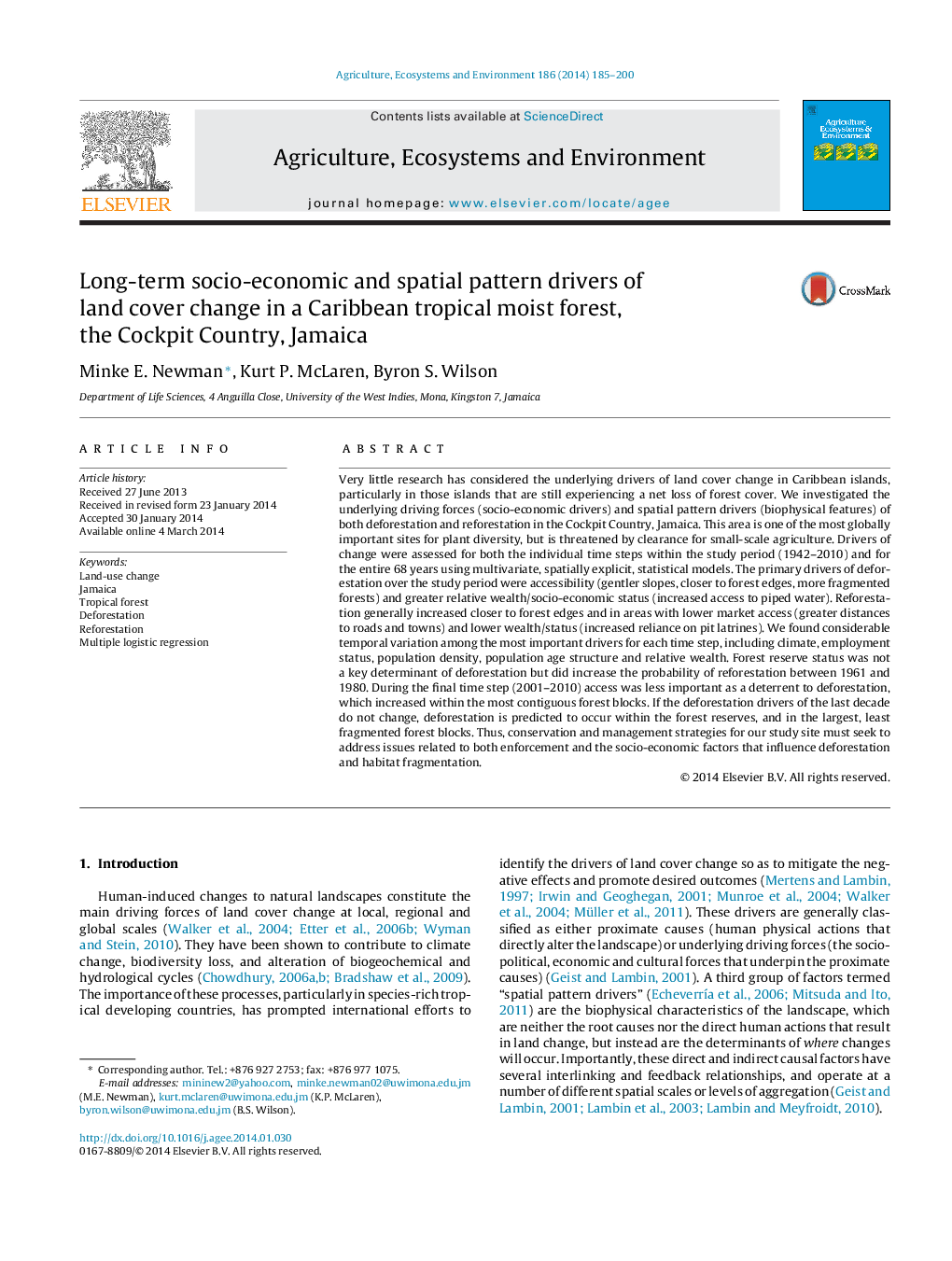| کد مقاله | کد نشریه | سال انتشار | مقاله انگلیسی | نسخه تمام متن |
|---|---|---|---|---|
| 8487927 | 1552066 | 2014 | 16 صفحه PDF | دانلود رایگان |
عنوان انگلیسی مقاله ISI
Long-term socio-economic and spatial pattern drivers of land cover change in a Caribbean tropical moist forest, the Cockpit Country, Jamaica
ترجمه فارسی عنوان
رانندگان الگوی اجتماعی و اقتصادی درازمدت تغییرات پوشش زمین در یک جنگل مرطوب گرمسیری کارائیب، کشور کابین خلبان، جامائیکا
دانلود مقاله + سفارش ترجمه
دانلود مقاله ISI انگلیسی
رایگان برای ایرانیان
کلمات کلیدی
تغییر کاربری زمین، جامائیکا، جنگل استوایی، جنگل زدایی، جنگل زدایی، رگرسیون لجستیک چندگانه،
ترجمه چکیده
تحقیقات بسیار کمی در برگیرنده تغییرات پوشش زمین در جزایر کارائیب بوده است، به ویژه در جزایر هایی که هنوز در معرض خسارت ناشی از جنگل قرار دارند. ما راننده های راننده (رانندگان اجتماعی و اقتصادی) و رانندگان الگوهای فضایی (ویژگی های بیوفیزیکی) هر دو جنگل زدایی و جنگل زدایی در کشور کابین خلبان جامائیکا را مورد بررسی قرار دادیم. این منطقه یکی از مکان های مهم جهانی برای تنوع گیاهان است، اما از نظر پاکیزگی برای کشاورزی در مقیاس کوچک تهدید می شود. رانندگان تغییر برای هر دو گام زمانی فرد در دوره مطالعه (1942-2010) و برای 68 سال با استفاده از مدل های آماری چند متغیره، مکانی صریح، مورد سنجش قرار گرفتند. رانندگان اصلی جنگل زدایی در طول دوره مطالعه دسترسی (دامنه های شلوغ، نزدیک به لبه های جنگل، جنگل های تکه تکه ای بیشتر) و وضعیت نسبی ثروت / وضعیت اجتماعی / اقتصادی (افزایش دسترسی به آب لوله کشی) بود. جنگل زراعی به طور کلی به لبه های جنگل و مناطقی با دسترسی به بازار کمتر (فاصله های بیشتری نسبت به جاده ها و شهرها) و ثروت / وضعیت پایین تر (افزایش وابستگی به دروازه های گودال) افزایش یافته است. ما تغییرات زمانی قابل توجهی را در میان مهم ترین رانندگان برای هر گام زمانی، از جمله آب و هوا، وضعیت اشتغال، تراکم جمعیت، ساختار سنی جمعیت و ثروت نسبی یافتیم. وضعیت ذخیره جنگل تعیین کننده اصلی جنگل زدایی نبود، اما احتمال افزایش جنگل های زراعی بین سال های 1961 و 1980 را افزایش داد. در طول مرحله نهایی (2001 تا 2010) دسترسی به اهداف جنگل نابود شد، که در میان بلوک های جنگلی . اگر رانندگان جنگلزدایی دهه گذشته تغییری نداشته باشند، جنگل زدایی پیش بینی می شود که در داخل جنگل ها و در بزرگترین بلوک های جنگلی تقسیم شده رخ دهد. بنابراین، استراتژی های حفاظت و مدیریت سایت مطالعه ما باید با توجه به مسائل مربوط به اجرای و عوامل اجتماعی-اقتصادی که بر روی جنگل زدایی و تکه تکه شدن زیستگاه تأثیر می گذارد، مورد توجه قرار گیرند.
موضوعات مرتبط
علوم زیستی و بیوفناوری
علوم کشاورزی و بیولوژیک
علوم زراعت و اصلاح نباتات
چکیده انگلیسی
Very little research has considered the underlying drivers of land cover change in Caribbean islands, particularly in those islands that are still experiencing a net loss of forest cover. We investigated the underlying driving forces (socio-economic drivers) and spatial pattern drivers (biophysical features) of both deforestation and reforestation in the Cockpit Country, Jamaica. This area is one of the most globally important sites for plant diversity, but is threatened by clearance for small-scale agriculture. Drivers of change were assessed for both the individual time steps within the study period (1942-2010) and for the entire 68 years using multivariate, spatially explicit, statistical models. The primary drivers of deforestation over the study period were accessibility (gentler slopes, closer to forest edges, more fragmented forests) and greater relative wealth/socio-economic status (increased access to piped water). Reforestation generally increased closer to forest edges and in areas with lower market access (greater distances to roads and towns) and lower wealth/status (increased reliance on pit latrines). We found considerable temporal variation among the most important drivers for each time step, including climate, employment status, population density, population age structure and relative wealth. Forest reserve status was not a key determinant of deforestation but did increase the probability of reforestation between 1961 and 1980. During the final time step (2001-2010) access was less important as a deterrent to deforestation, which increased within the most contiguous forest blocks. If the deforestation drivers of the last decade do not change, deforestation is predicted to occur within the forest reserves, and in the largest, least fragmented forest blocks. Thus, conservation and management strategies for our study site must seek to address issues related to both enforcement and the socio-economic factors that influence deforestation and habitat fragmentation.
ناشر
Database: Elsevier - ScienceDirect (ساینس دایرکت)
Journal: Agriculture, Ecosystems & Environment - Volume 186, 15 March 2014, Pages 185-200
Journal: Agriculture, Ecosystems & Environment - Volume 186, 15 March 2014, Pages 185-200
نویسندگان
Minke E. Newman, Kurt P. McLaren, Byron S. Wilson,
